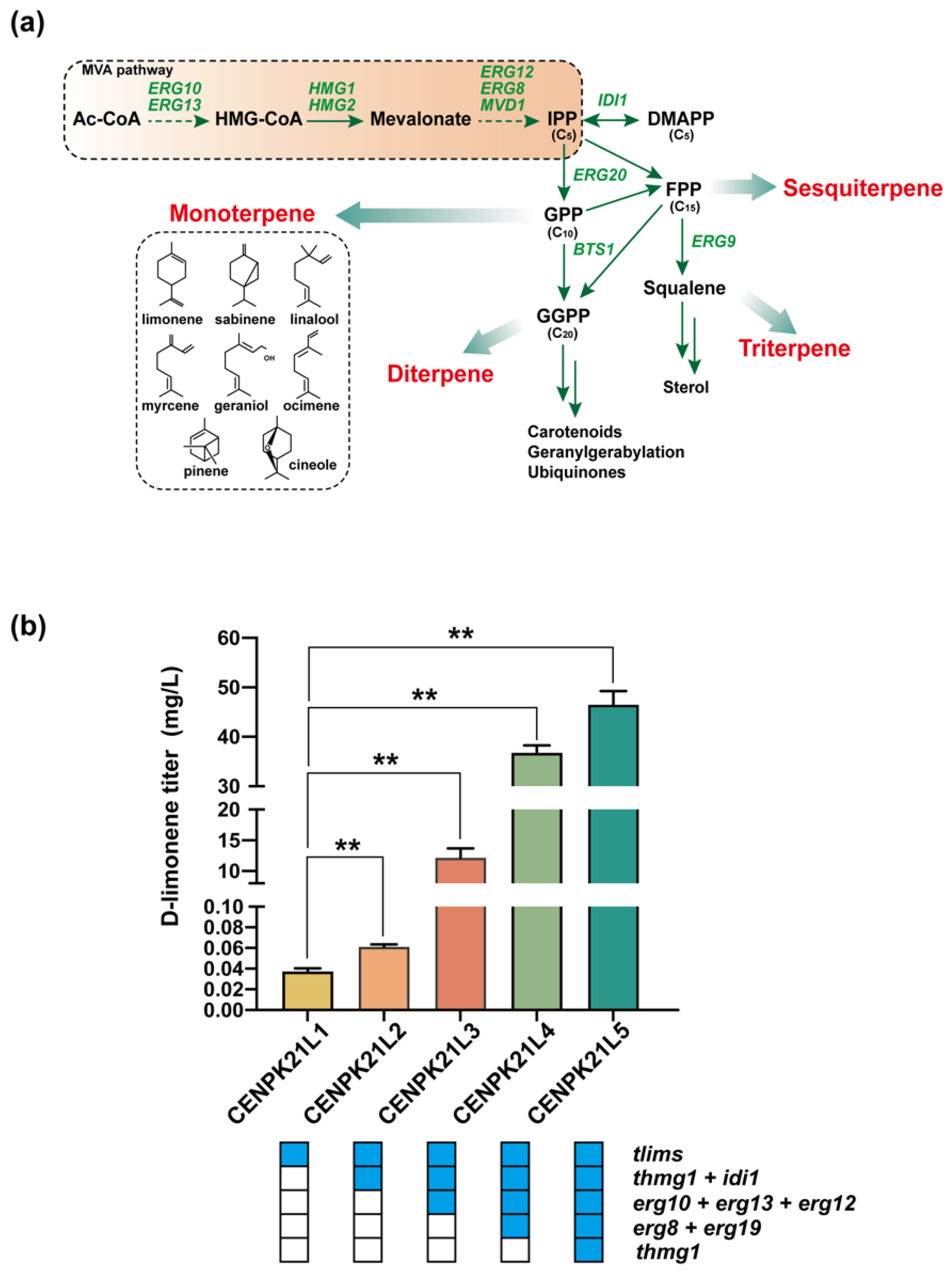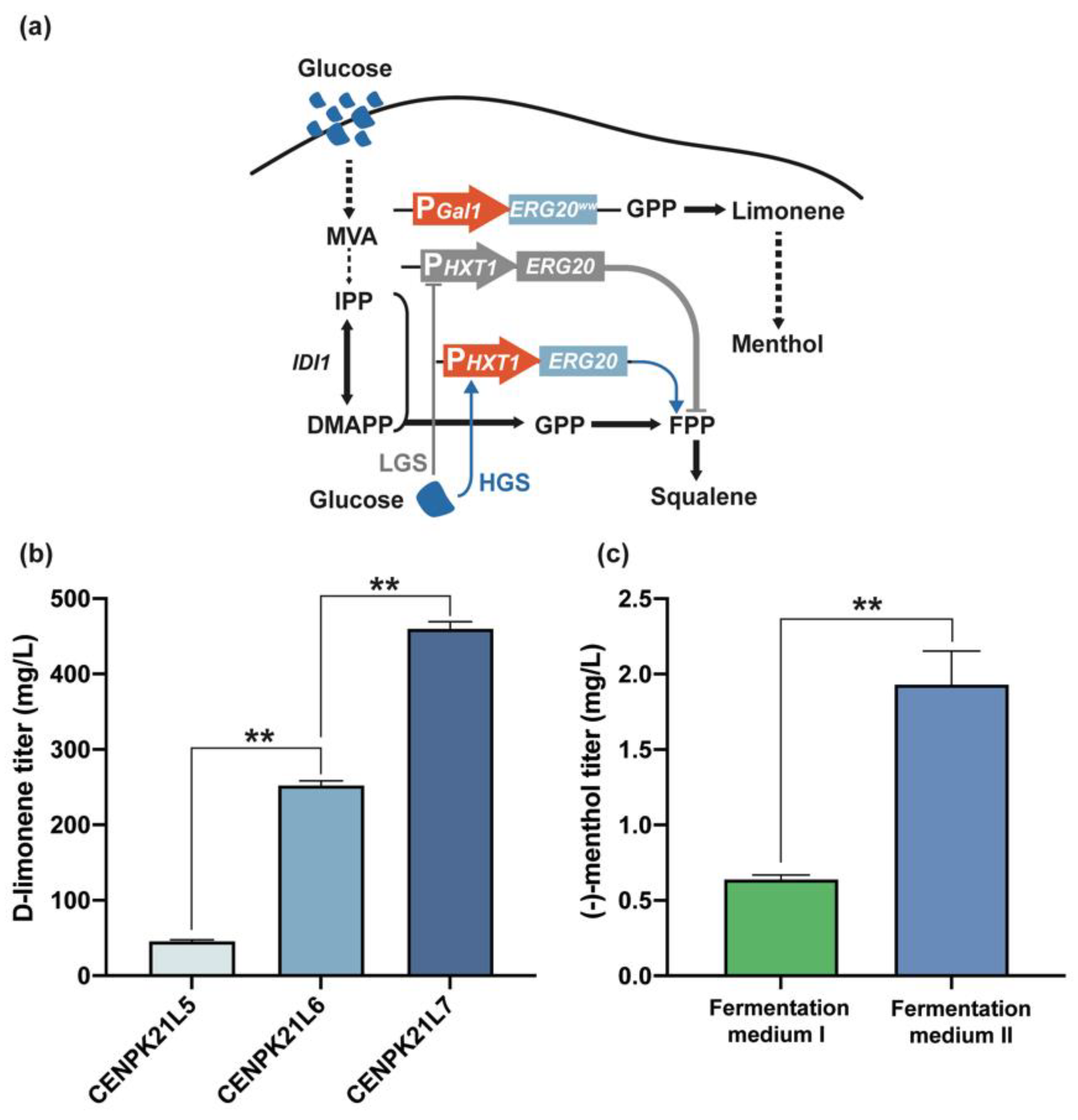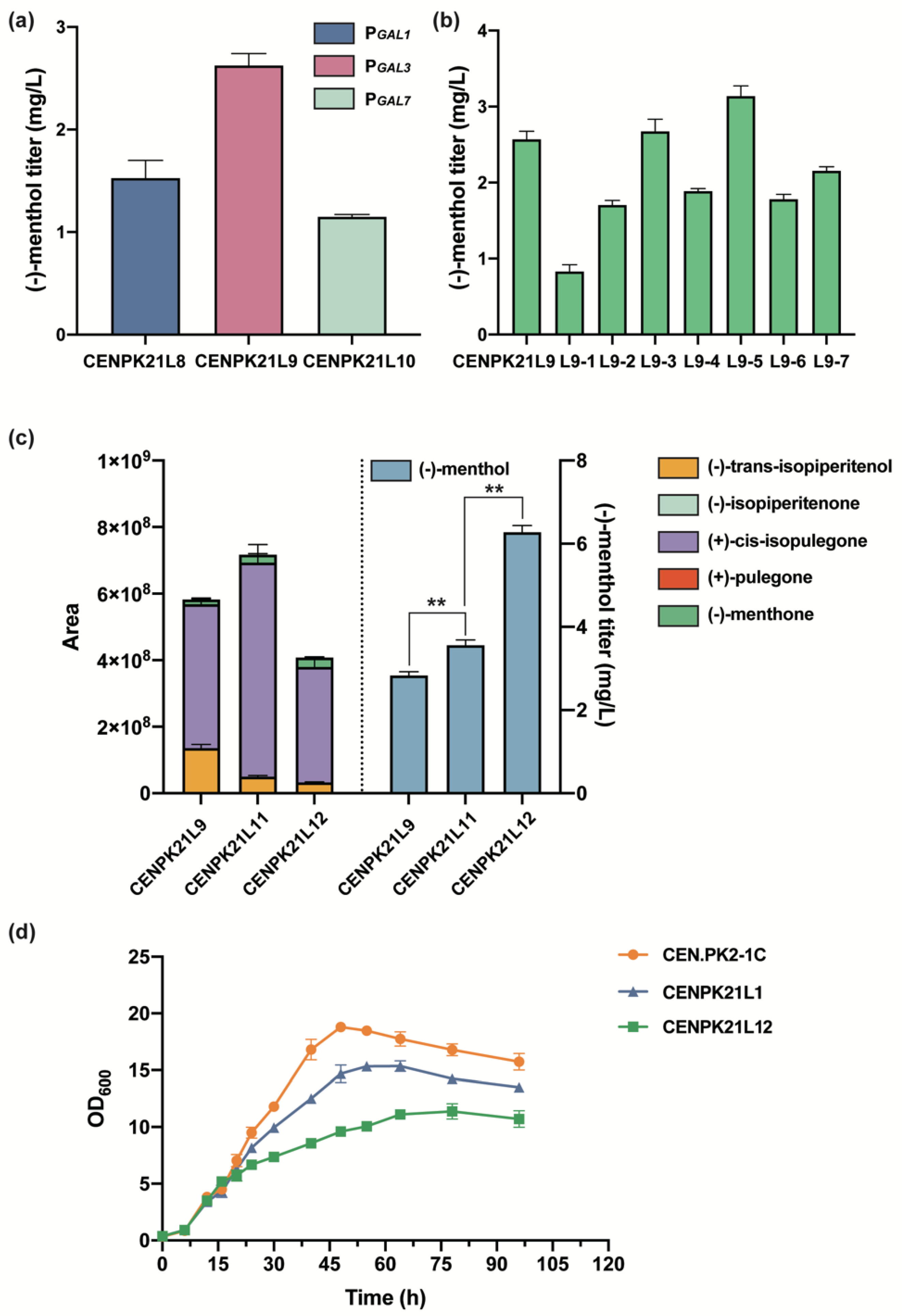Engineered Saccharomyces cerevisiae for the De Novo Biosynthesis of (−)-Menthol
Abstract
:1. Introduction
2. Materials and Methods
2.1. Medium and Cultural Conditions
2.2. Construction of Plasmids and Recombinant Strains
2.3. Two-Phase Flask Cultivation for D-Limonene Production
2.4. Confocal Imaging
2.5. Fermentation and Extraction for Menthol Production
2.6. Gas Chromatography–Mass Spectrometry Analysis
2.7. Statistical Analysis
3. Results and Discussion
3.1. Construction of the (−)-Menthol De Novo Biosynthetic Pathway
3.2. Enhancement of the MVA Pathway to Improve D-Limonene Synthesis
3.3. Dynamic Regulation of ERG20 Gene Expression
3.4. Optimization of the Downstream Pathway for (−)-Menthol Synthesis
4. Conclusions
Supplementary Materials
Author Contributions
Funding
Institutional Review Board Statement
Informed Consent Statement
Data Availability Statement
Conflicts of Interest
References
- Kamatou, G.P.; Vermaak, I.; Viljoen, A.M.; Lawrence, B.M. Menthol: A simple monoterpene with remarkable biological properties. Phytochemistry 2013, 96, 15–25. [Google Scholar] [CrossRef] [PubMed]
- Yu, Z.; Yu, H.; Xu, J.; Wang, Z.; Kang, T.; Chen, K.; Pu, Z.; Wu, J.; Yang, L.; Xu, G. Enhancing thermostability of lipase from Pseudomonas alcaligenes for producing L-menthol by the CREATE strategy. Catal. Sci. Technol. 2022, 12, 2531. [Google Scholar] [CrossRef]
- Lange, B.M. Biosynthesis and biotechnology of high-value p-menthane monoterpenes, including menthol, carvone, and limonene. Adv. Biochem. Eng. Biotechnol. 2015, 148, 319–353. [Google Scholar]
- Tiwari, P. Recent advances and challenges in trichome research and essential oil biosynthesis in Mentha arvensis L. Ind. Crop. Prod. 2016, 82, 141–148. [Google Scholar] [CrossRef]
- Paddon, C.J.; Westfall, P.J.; Pitera, D.J.; Benjamin, K.; Fisher, K.; McPhee, D.; Leavell, M.D.; Tai, A.; Main, A.; Eng, D.; et al. High-level semi-synthetic production of the potent antimalarial artemisinin. Nature 2013, 496, 528–532. [Google Scholar] [CrossRef] [PubMed]
- Xu, Y.; Wang, X.; Zhang, C.; Zhou, X.; Xu, X.; Han, L.; Lv, X.; Liu, Y.; Liu, S.; Li, J.; et al. De Novo biosynthesis of rubusoside and rebaudiosides in engineered yeasts. Nat. Commun. 2022, 13, 3040. [Google Scholar] [CrossRef] [PubMed]
- Zheng, S.; Zeng, T.; Li, C.; Chen, B.; Coley, C.W.; Yang, Y.; Wu, R. Deep learning driven biosynthetic pathways navigation for natural products with BioNavi-NP. Nat. Commun. 2022, 13, 3342. [Google Scholar] [CrossRef]
- Currin, A.; Dunstan, M.S.; Johannissen, L.O.; Hollywood, K.A.; Vinaixa, M.; Jervis, A.J.; Swainston, S.N.; Rattray, N.J.W.; Gardiner, J.M.; Kell, D.B.; et al. Engineering the “missing link” in biosynthetic (−)-menthol production: Bacterial isopulegone isomerase. ACS Catal. 2018, 8, 2012–2020. [Google Scholar] [CrossRef]
- Toogood, H.S.; Cheallaigh, A.N.; Tait, S.; Mansell, D.J.; Jervis, A.; Lygidakis, A.; Humphreys, L.; Takano, E.; Gardiner, J.M.; Scrutton, N.S.; et al. Enzymatic menthol production: One-pot approach using engineered Escherichia coli. ACS Synth. Biol. 2015, 4, 1112–1123. [Google Scholar] [CrossRef]
- Kim, E.M.; Eom, J.H.; Um, Y.; Kim, Y.; Woo, H.M. Microbial synthesis of myrcene by metabolically engineered Escherichia coli. J. Agric. Food Chem. 2015, 63, 4606–4612. [Google Scholar] [CrossRef]
- Dambolena, J.S.; López, A.G.; Rubinstein, H.R.; Zygadlo, J.A. Effects of menthol stereoisomers on the growth, sporulation and fumonisin b1 production of fusarium verticillioides. Food Chem. 2010, 123, 165–170. [Google Scholar] [CrossRef]
- Pankow, J.F. The stereoisomers of menthol in selected tobacco products. A brief report. Nicotine Tob. Res. 2011, 13, 741–745. [Google Scholar]
- Apel, A.R.; d’Espaux, L.; Wehrs, M.; Sachs, D.; Li, R.A.; Tong, G.J.; Garber, M.; Nnadi, O.; Zhuang, W.; Hillson, N.J.; et al. A Cas9-based toolkit to program gene expression in Saccharomyces cerevisiae. Nucleic Acids Res. 2017, 45, 496–508. [Google Scholar]
- Cai, P.; Gao, J.; Zhou, Y. CRISPR-mediated genome editing in non-conventional yeasts for biotechnological applications. Microb. Cell Fact. 2019, 18, 63. [Google Scholar] [CrossRef]
- Alonso-Gutierrez, J.; Chan, R.; Batth, T.S.; Adams, P.D.; Keasling, J.D.; Petzold, C.J.; Lee, T.S. Metabolic engineering of Escherichia coli for limonene and perillyl alcohol production. Metab. Eng. 2013, 19, 33–41. [Google Scholar] [CrossRef]
- Tao, W.; Li, S.; Zhang, B.; Bi, C.; Zhang, X. Engineering Saccharomyces cerevisiae for the production of the valuable monoterpene ester geranyl acetate. Microb. Cell Fact. 2018, 17, 85. [Google Scholar]
- Khor, G.K.; Uzir, M.H. Saccharomyces cerevisiae: A potential stereospecific reduction tool for biotransformation of mono- and sesquiterpenoids. Yeast 2011, 28, 93–107. [Google Scholar] [CrossRef]
- Paramasivan, K.; Mutturi, S. Progress in terpene synthesis strategies through engineering of Saccharomyces cerevisiae. Crit. Rev. Biotechnol. 2017, 37, 974–989. [Google Scholar] [CrossRef]
- Williams, D.C.; Mcgarvey, D.J.; Katahira, E.J.; Croteau, R. Truncation of limonene synthase preprotein provides a fully active ‘pseudomature’ form of this monoterpene cyclase and reveals the function of the amino-terminal arginine pair. Biochemistry 1998, 37, 12213–12220. [Google Scholar] [CrossRef]
- Cheng, S.; Liu, X.; Jiang, G.; Wu, J.; Zhao, G.R. Orthogonal engineering of biosynthetic pathway for efficient production of limonene in Saccharomyces cerevisiae. ACS Synth. Biol. 2019, 8, 968–975. [Google Scholar] [CrossRef]
- Du, F.L.; Yu, H.L.; Xu, J.H.; Li, C.X. Enhanced limonene production by optimizing the expression of limonene biosynthesis and MEP pathway genes in E. coli. Biores. Bioprocess. 2014, 1, 10. [Google Scholar] [CrossRef]
- Brennan, T.; Turner, C.D.; KroMer, J.O.; Nielsen, L.K. Alleviating monoterpene toxicity using a two-phase extractive fermentation for the bioproduction of jet fuel mixtures in Saccharomyces cerevisiae. Biotechnol. Bioeng. 2012, 109, 2513–2522. [Google Scholar] [CrossRef] [PubMed]
- Ignea, C.; Pontini, M.; Maffei, M.E.; Makris, A.M.; Kampranis, S.C. Engineering monoterpene production in yeast using a synthetic dominant negative geranyl diphosphate synthase. ACS Synth. Biol. 2014, 3, 298–306. [Google Scholar] [CrossRef] [PubMed]
- Zhao, J.; Li, C.; Zhang, Y.; Shen, Y.; Hou, J.; Bao, X. Dynamic control of ERG20 expression combined with minimized endogenous downstream metabolism contributes to the improvement of geraniol production in Saccharomyces cerevisiae. Microb. Cell Fact. 2017, 16, 17. [Google Scholar] [CrossRef] [Green Version]
- Jiang, G.Z.; Yao, M.D.; Wang, Y.; Zhou, L.; Song, T.Q.; Liu, H.; Xiao, W.H.; Yuan, Y.J. Manipulation of GES and ERG20 for geraniol overproduction in Saccharomyces cerevisiae. Metab. Eng. 2017, 41, 57–66. [Google Scholar] [CrossRef]
- Ai, L.; Guo, W.; Chen, W.; Teng, Y.; Bai, L. The gal80 deletion by CRISPR-Cas9 in engineered Saccharomyces cerevisiae produces artemisinic acid without galactose induction. Curr. Microbiol. 2019, 76, 1313–1319. [Google Scholar] [CrossRef]




| Strain | Host Strain | Description | Source |
|---|---|---|---|
| CEN.PK2-1C | Lab work | ||
| CENPK21M1 | CEN.PK2-1C | △gal80: PGAL10-LimS, △YPRCδ15c::CPR1-PGAL1,10-L3H, △208a:IPDH-PGAL1,10-IPR, △1622b::KSI-PGAL1,10-PGR, △1021b: PGAL1-MMR | This study |
| CENPK21M2 | CEN.PK2-1C | △gal80: PGAL10-tLims, △YPRCδ15c::CPR1-PGAL1,10-L3H, △208a:IPDH-PGAL1,10-IPR, △1622b::KSI-PGAL1,10-PGR, △1021b: PGAL1-MMR | This study |
| CENPK21L1 | CEN.PK2-1C | △gal80: PGAL10-tLims | This study |
| CENPK21L2 | CENPK21L1 | △1014a:tHMG1-PGAL1,10-IDI1 | This study |
| CENPK21L3 | CENPK21L2 | △416d:ERG10-PGAL1,10-ERG13-PGAL7-ERG12 | This study |
| CENPK21L4 | CENPK21L3 | △1309a:ERG19-PGAL1,10-ERG8 | This study |
| CENPK21L5 | CENPK21L3 | △1309a:ERG19-PGAL1,10-ERG8-PGAL7-tHMG1 | This study |
| CENPK21L6 | CENPK21L5 | △911b:PGAL1-ERG20ww, PERG20-ERG20::PHXT1 | This study |
| CENPK21L7 | CENPK21L6 | △SAP115b:ERG20ww-PGAL1,10-tLims | This study |
| CENPK21L8 | CENPK21L7 | △YPRCδ15c:CPR1-PGAL1,10-L3H, △208a:IPDH-PGAL1,10-IPR, △1622b:KSI-PGAL1,10-PGR, △1021b: PGAL1-MMR | This study |
| CENPK21L9 | CENPK21L8 | PGAL1-MMR:PGAL3 | This study |
| CENPK21L10 | CENPK21L8 | PGAL1-MMR:PGAL7 | This study |
| L9-1 | CENPK21L9 | PY26-L3H | This study |
| L9-2 | CENPK21L9 | PY26-L3H-CPR1 | This study |
| L9-3 | CENPK21L9 | PY26-IPDH | This study |
| L9-4 | CENPK21L9 | PY26-IPR | This study |
| L9-5 | CENPK21L9 | PY26-KSI | This study |
| L9-6 | CENPK21L9 | PY26-PGR | This study |
| L9-7 | CENPK21L9 | PY26-MMR | This study |
| CENPK21L11 | CENPK21L9 | △308a: PGAL1-IPDH | This study |
| CENPK21L12 | CENPK21L11 | △308a: PGAL1-KSI | This study |
Publisher’s Note: MDPI stays neutral with regard to jurisdictional claims in published maps and institutional affiliations. |
© 2022 by the authors. Licensee MDPI, Basel, Switzerland. This article is an open access article distributed under the terms and conditions of the Creative Commons Attribution (CC BY) license (https://creativecommons.org/licenses/by/4.0/).
Share and Cite
Lv, X.; Zhou, X.; Ma, J.; Tao, M.; Liu, Y.; Li, J.; Du, G.; Liu, L. Engineered Saccharomyces cerevisiae for the De Novo Biosynthesis of (−)-Menthol. J. Fungi 2022, 8, 982. https://doi.org/10.3390/jof8090982
Lv X, Zhou X, Ma J, Tao M, Liu Y, Li J, Du G, Liu L. Engineered Saccharomyces cerevisiae for the De Novo Biosynthesis of (−)-Menthol. Journal of Fungi. 2022; 8(9):982. https://doi.org/10.3390/jof8090982
Chicago/Turabian StyleLv, Xueqin, Xuan Zhou, Jun Ma, Mengrui Tao, Yanfeng Liu, Jianghua Li, Guocheng Du, and Long Liu. 2022. "Engineered Saccharomyces cerevisiae for the De Novo Biosynthesis of (−)-Menthol" Journal of Fungi 8, no. 9: 982. https://doi.org/10.3390/jof8090982






